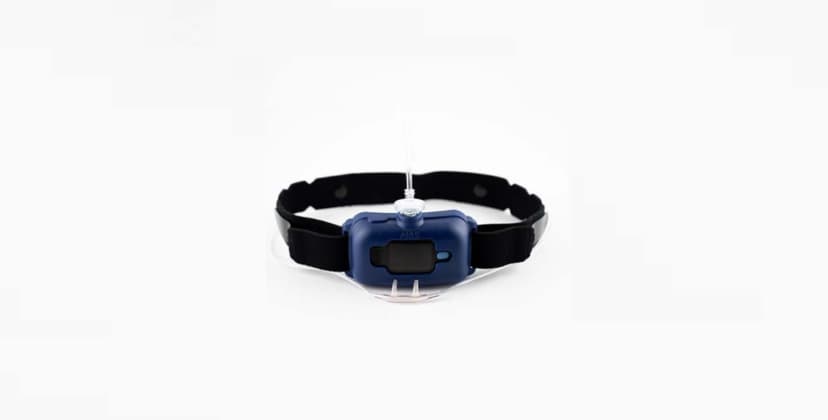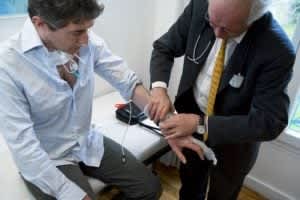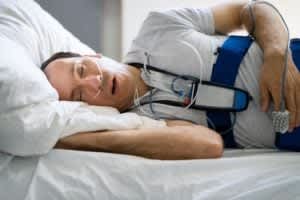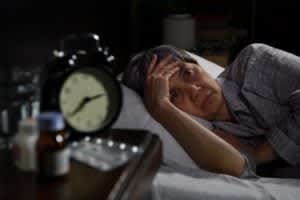Price:
$3,380When you buy through our links, we may earn a commission. Products or services may be offered by an affiliated entity. Learn more.
Watermark Medical ARES Review

WaterMark Medical Ares 620

Sleep Foundation Special Offer
Use this SleepFoundation.org link for the most current discount on WaterMark Medical products
The Watermark Medical ARES 620 is an at-home sleep apnea test that measures nine breathing and sleep health metrics. It’s designed as an alternative to a lab-based sleep study to determine if a person has obstructive sleep apnea (OSA). It’s only available for purchase by health care providers and is intended for prescription use.
We’ll break down how the ARES 620 at-home sleep apnea test works and explain how the nine sleep data measurements can help detect OSA. We’ll also discuss who’s a good candidate for this device and who may prefer a different type of sleep study.
What Is Obstructive Sleep Apnea (OSA)?
OSA is a common sleep disorder that causes irregular breathing. People with OSA gasp, choke, and snort in their sleep when their upper airway becomes blocked. It’s typically caused by the relaxation of throat muscles during sleep. When the airway narrows it can result in apneas or hypopneas, which are pauses in breathing or insufficient breaths.
Physicians determine OSA severity using the apnea-hypopnea index (AHI). This measurement reflects the average number of apneas and hypopneas a person has during an hour of sleep. People with mild OSA can experience as few as five apneic events in an hour, while those with severe OSA have 30 or more.
| Sleep Apnea Severity | AHI Score |
|---|---|
| Mild OSA | 5-15 |
| Moderate OSA | 15-30 |
| Severe OSA | 30 or higher |
An estimated 10% to 30% of U.S. adults have obstructive sleep apnea. Certain populations are more likely to have OSA, such as individuals with high body mass index (BMI) scores, men or people assigned male at birth, and those with coronary disease. Untreated OSA can lead to health problems, including diabetes, cardiovascular issues, and depression.
Loud snoring is one of the most common OSA symptoms. Others include irritability, morning headaches, forgetfulness, and excessive sleepiness. If you suspect that you may have OSA, an at-home sleep apnea test is an excellent first step toward effective treatment.
How Does the Watermark Medical ARES Work?
The Watermark Medical ARES 620 is cleared by the Food and Drug Administration as an at-home OSA test. The device consists of a headband with a forehead sensor, plus a nasal cannula with prongs that are inserted in the nostrils. Together, the sensors track nine primary metrics that can help your health care team determine if you have OSA.
- Pulse rate: The device measures your pulse and records noteworthy changes. While basic, this information can be useful for physicians because it allows them to track any correlations between disordered breathing and heart rate.
- Oxygen saturation: The forehead sensor monitors your peripheral oxygen saturation (SpO2) to detect below-average levels, also called hypoxemia. Your body needs an adequate blood oxygen level to function correctly. Research shows that apneas and hypopneas can cause oxygen desaturation, which can lead to adverse health effects.
- Sleep latency and efficiency: Sleep latency refers to how long it takes you to fall asleep, while sleep efficiency indicates the percentage of time you’re actually asleep while in bed. When tracked together they can provide information about your sleep quality.
- Body and head positions: Certain sleeping positions may make breathing more difficult than others. The ARES device tracks your sleep position to see if you have more sleep apnea events while on your back, side, or stomach. It also records your head position and head movements throughout the night.
- Snoring: Frequent snoring is one of the most noticeable symptoms of OSA. The device has a microphone that records how often and loudly you snore.
- Airflow: The nasal cannula measures how strong your breaths are throughout the night, which can help identify apneic events.
- Three neurological indicators: This at-home test includes electrodes that track brain activity, eye movement, and muscle response. These neurological metrics can help track your sleep stages. For some people, OSA is more prevalent during rapid eye movement (REM) sleep.
- Respiratory effort (optional add-on): Some sleep specialists may require you to wear an additional component around your chest called an effort belt. It contains a sensor that detects respiratory effort, which can help physicians better understand how your breath quality varies throughout the night.
How Do You Set Up and Use the Watermark Medical ARES?
The Watermark Medical ARES 620 isn’t available for consumers to purchase, so the first step is to find a health care provider who uses the device as part of an at-home sleep study. Once you locate a provider, they’ll likely have you complete a questionnaire before renting the device to you.
The ARES device is easy to set up and use. The main device component rests against your forehead and is secured by a headband that wraps around the back of your head. A nasal cannula attaches to the top of the device and has prongs that are inserted in your nostrils. Your provider may include an optional effort belt that’s worn across the chest.
- Step 1: Before putting the device on, carefully read the instructions. Make sure that any noise-producing electronics are turned off, as the device’s microphone may pick up background sounds.
- Step 2: Take the adhesive off the electrodes on the back of the forehead sensor and hold the nasal cannula in place while you slide the band over your head. The main device should be above your eyebrows and centered on your forehead. Make sure your hair doesn’t come between the electrodes and your skin. If you have long hair, wear it up.
- Step 3: Put the cannula prongs inside your nostrils and use the slider on top of your head to get a snug fit.
- Step 4: Press the power button on top of the unit and wait about 10 seconds for the device to start up. It will give you an auditory alert when you can start the test and go to sleep.
- Step 5: When you wake up, the device may have shut off already on its own. If there’s a green light illuminated, use the power button to stop the test.
- Step 6: Return the device to your provider and wait for your sleep test results. As long as the device worked correctly, your physician should have enough data to provide you with a diagnosis.
- Step 7: If your doctor determines that you have OSA, they may prescribe continuous positive airway pressure (CPAP) therapy and make a referral for a titration study to determine the right pressure level for your needs.
It’s critical that you wear each component properly and ensure that the device is tracking data to get the most comprehensive sleep information possible. If an alarm sounds while you’re sleeping, you may need to reposition the device. After adjusting the nasal cannula and headband, shake your head back and forth to shut the alarm off. If the alarm sounds more than two times, you’ll need to contact your physician to set up a second study.
Who Should Use the Watermark Medical ARES?
The Watermark Medical ARES 620 is an FDA-cleared at-home sleep apnea test that’s worth considering if you want to avoid going to a sleep lab. It’s an excellent choice if you want sleep stage and brain activity information, which more basic at-home tests don’t monitor.
Some people may find this test more comfortable than others. Unlike many at-home sleep apnea tests, the ARES device doesn’t include a pulse oximeter that attaches to the index finger. The standard unit also omits a chest sensor, giving it a smaller overall footprint than comparable devices.
The ARES 620 also tracks more metrics than the average at-home sleep apnea test. Devices that use a finger sensor instead of a forehead sensor are unable to track brain wave activity. The ARES device also monitors eye and head movements to help determine how your breathing and sleep stages interact.
Though this test has many positive attributes, it may be more thorough than some people need. If your health care team isn’t concerned about gathering sleep stage data, you may want to choose a basic at-home sleep apnea test to save money.
Pros and Cons of the Watermark Medical ARES
There are several qualities that make the Watermark Medical ARES 620 an at-home sleep apnea test that’s worth considering.
- Records neurological data: This test has electrodes that monitor brain activity and sleep stages, which most other at-home sleep apnea tests don’t include.
- Minimally invasive: You only need to wear a headband and nasal cannula during this test.
- Comprehensive: The device captures nine key data points, giving your health care team an in-depth look at your breathing and sleep health.
Though this at-home sleep apnea testing device has numerous advantages, there are a few drawbacks to keep in mind.
- Requires a prescription: Unlike some at-home sleep apnea tests, this device is only available with a prescription from your doctor.
- Comfort considerations: The headband may not be comfortable for some people to wear at night, especially stomach sleepers.
- Sensor restrictions: If the headband or nasal cannula becomes dislodged more than twice, the device will shut off and you’ll have to contact your physician to set up another test.
Cost, Shipping, and Returns
The ARES 620 is only available on a rental basis from authorized health care providers. If you know you’d like to use this at-home sleep apnea test, you’ll need to work with your health care team to facilitate a device rental and test.
Though prices vary depending on the provider, the ARES at-home sleep apnea test is likely more affordable than an in-person study at a sleep lab. Insurance plans often cover sleep apnea tests, though you’ll have to check with your individual provider for details.
Shipping, returns, and device rental specifics vary by health care provider.
The Bottom Line
The Watermark Medical ARES 620 is a great fit for people seeking an at-home sleep apnea test with powerful diagnostics. The inclusion of electrodes to measure neurological activity sets this device apart and gives physicians a more complete picture of your sleep health and breathing than basic at-home sleep apnea tests provide.
However, it’s only available with a doctor’s prescription. If you decide you’d like to use it, you’ll need to find a physician who can offer it to you as a rental or as part of a sleep study package.

Still have questions?
Our product experts have extensive experience testing just about every sleep product on the market. Send an email to AskAnExpert@sleepfoundation.org or call us at (877) 672-8966 with your questions and we’ll help you find exactly what you’re looking for.









